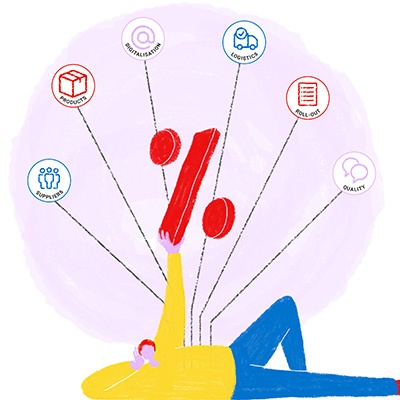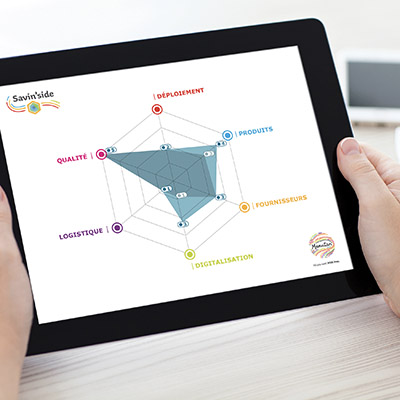In the context of the European Green Deal, the European Union (EU) clearly displays its ambition: To become the first continent to achieve climate neutrality by 2050. This implies eliminating as many greenhouse gas emissions as it produces. To achieve this, it has adapted its policies on climate, energy, land use, transport and taxation. It is in this context that the Carbon Border Adjustment Mechanism (CBAM) - also known as the European carbon tax or border carbon tax - entered its transitional phase on October 1, 2023. This new EU regulatory instrument is set to change the landscape for industries and their procurement departments.
What is the Carbon Border Adjustment Mechanism (CBAM)?
The Carbon Border Adjustment Mechanism (CBAM) is a new European regulatory instrument. It consists of subjecting imported products into the European Union to carbon pricing, corresponding to that currently applied to European industrialists. More concretely, certain carbon-intensive goods will soon be subject to a surcharge for importers when they cross the European borders.
As you can understand, this system aims to combat carbon leakage. The European Union is implementing a number of stringent climate measures to reduce greenhouse gas emissions within its territory. This mechanism ensures that European policies are not compromised by the relocation of production to countries with less ambitious environmental standards, or by the replacement of European products with imports that have a higher carbon footprint.
Initially, this regulatory instrument covers certain goods that are highly exposed to the risk of carbon leakage. These are iron and steel, cement, fertiliser, aluminium, electricity and hydrogen. These sectors account for nearly half of industrial emissions within the EU. This list is likely to gradually expand to include other industrial sectors, such as refining and chemicals.
How does CBAM work?
Today, European companies are allocated greenhouse gas emission quotas. When they exceed these, they have to pay a surcharge, the amount of which is defined by the carbon market.
CBAM will thus make it possible to apply surcharges on imported goods when they enter the European market. These additional costs will depend on the carbon emissions of companies located in third countries and will be based on the prices of the EU Emissions Trading Scheme (EU ETS).
This system will be gradually implemented until 2034. A transitional application phase is planned from October 1, 2023, to December 31, 2025, during which importers will be required to declare the quantity of goods imported, their direct and indirect greenhouse gas emissions, as well as any carbon price due for these emissions. No financial payment is imposed during this period. It is a pilot and a learning phase for all stakeholders, namely importers, producers, and the authorities.
CBAM will therefore not fully enter into force until 1 January 2026. It will then be up to companies importing carbon-intensive goods into the EU to pay a tax on the CO2 emitted during their manufacture abroad. This will take the form of certificates to be purchased from national authorities.
What impact will CBAM have on the procurement function?
CBAM is set to reshape the carbon pricing landscape. This will have a major impact on European companies that import regulated goods, and particularly their procurement departments.
Collecting data
Initially, the major challenge of this measure is data collection. This data must be transmitted by exporters from third countries to European importers. From now on, businesses must map their value chain to identify the goods concerned. Procurement departments must then collaborate with their suppliers to obtain accurate data, work on improving results, and ensure the security of this sensitive data. This may include reviewing contracts to incorporate relevant clauses.
Rethinking your supply chain
CBAM will also influence procurement decisions within European companies. After identifying impacted suppliers, procurement departments must assess their compliance and ability to supply low-carbon products. This may involve shifting to other producers where possible. However, this does not necessarily mean they will stop sourcing from non-European producers, but reflection and discussions will need to take place to align with their procurement strategy.
Anticipating price increases
From 2026, the prices of goods covered by this measure are likely to increase. Import prices will rise due to CBAM surcharges, as will the prices of goods produced within the EU due to the gradual phasing out of free quotas. Moreover, importers will have to absorb higher associated administrative costs to comply. Procurement departments must prepare for this to preserve their company’s profitability.
-
83% of decision makers expect prices to rise;
-
75% believe it will influence their procurement decisions;
-
58% are not certain it will encourage them to buy European.
Training and informing
The evolving carbon pricing landscape plays a key role in procurement decisions. This is why companies must ensure that their procurement teams, but also their suppliers, are trained on this strategic issue. This is how they will be able to grasp all the challenges, make informed decisions and even act proactively.
The Carbon Border Adjustment Mechanism (CBAM) represents a major step towards the EU’s goal of carbon neutrality. For businesses, understanding and integrating this mechanism into their procurement strategies is essential for effectively managing risks, contributing to the decarbonisation strategy and optimising costs. It is even an opportunity to position themselves as a leader in the transition towards a modern, sustainable and competitive economy.









